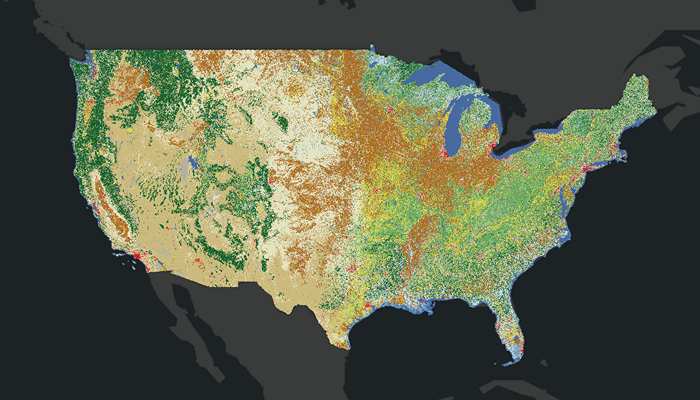Load a raster from a service, then apply a function to it.

Use case
Raster functions allow processing operations that can be applied to one or more rasters on the fly. Functions can be applied to rasters that come from a service. A land survey agency may apply hillshade and aspect functions to rasters with elevation data in order to better determine the topography of a landscape and to make further planning decisions.
How to use the sample
Tap the "Apply Layer" button to apply the raster function and display the result. Tap "Reset" to apply the image service raster back to the rasterLayer.
How it works
- Create the
ImageServiceRasterreferring to the image server URL. - Create the
RasterFunctionfrom a JSON string. - Get the arguments of the raster function with
rasterFunction.arguments. - Get the names of the raster arguments with
rasterFunctionArguments.rasterNames. - Set the raster argument with
rasterFunctionArguments.setRaster(rasterNames[0], imageServiceRaster). - Create a new
Rasterreferring to the raster function. - Create a
RasterLayerto visualize the computed raster. - Display the raster.
Relevant API
- ImageServiceRaster
- Raster
- RasterFunction
- RasterFunctionArguments
- RasterLayer
About the data
The sample applies a hillshade function to a raster produced from the National Land Cover Database, NLCDLandCover2001. You can learn more about the hillshade function in the ArcMap documentation.
Additional information
The raster function computation happens locally on the client device.
Tags
function, layer, raster, raster function, service
Sample Code
/* Copyright 2023 Esri
*
* Licensed under the Apache License, Version 2.0 (the "License");
* you may not use this file except in compliance with the License.
* You may obtain a copy of the License at
*
* http://www.apache.org/licenses/LICENSE-2.0
*
* Unless required by applicable law or agreed to in writing, software
* distributed under the License is distributed on an "AS IS" BASIS,
* WITHOUT WARRANTIES OR CONDITIONS OF ANY KIND, either express or implied.
* See the License for the specific language governing permissions and
* limitations under the License.
*
*/
package com.esri.arcgismaps.sample.applyfunctiontorasterfromservice
import android.os.Bundle
import android.util.Log
import androidx.appcompat.app.AppCompatActivity
import androidx.databinding.DataBindingUtil
import androidx.lifecycle.lifecycleScope
import com.arcgismaps.ApiKey
import com.arcgismaps.ArcGISEnvironment
import com.arcgismaps.LoadStatus
import com.arcgismaps.mapping.ArcGISMap
import com.arcgismaps.mapping.BasemapStyle
import com.arcgismaps.mapping.layers.RasterLayer
import com.arcgismaps.raster.ImageServiceRaster
import com.arcgismaps.raster.Raster
import com.arcgismaps.raster.RasterFunction
import com.esri.arcgismaps.sample.applyfunctiontorasterfromservice.databinding.ApplyFunctionToRasterFromServiceActivityMainBinding
import com.google.android.material.snackbar.Snackbar
import kotlinx.coroutines.launch
class MainActivity : AppCompatActivity() {
private val activityMainBinding: ApplyFunctionToRasterFromServiceActivityMainBinding by lazy {
DataBindingUtil.setContentView(this, R.layout.apply_function_to_raster_from_service_activity_main)
}
private val mapView by lazy {
activityMainBinding.mapView
}
private val imageServiceRaster: ImageServiceRaster by lazy {
ImageServiceRaster(getString(R.string.image_service_raster_url))
}
private val imageRasterLayer: RasterLayer by lazy {
RasterLayer(imageServiceRaster)
}
override fun onCreate(savedInstanceState: Bundle?) {
super.onCreate(savedInstanceState)
// authentication with an API key or named user is
// required to access basemaps and other location services
ArcGISEnvironment.apiKey = ApiKey.create(BuildConfig.ACCESS_TOKEN)
lifecycle.addObserver(mapView)
// create and add a map with a dark gray basemap style
val map = ArcGISMap(BasemapStyle.ArcGISDarkGray)
mapView.map = map
// add the imageRasterLayer to the map
addImageRasterLayer()
activityMainBinding.apply {
rasterButton.setOnClickListener {
// update the raster with simplified hillshade
applyRasterFunction()
resetButton.isEnabled = true
rasterButton.isEnabled = false
}
resetButton.setOnClickListener {
// reset map to back to the RasterLayer
addImageRasterLayer()
resetButton.isEnabled = false
rasterButton.isEnabled = true
}
}
}
/**
* Adds the image raster layer to the map and set's the viewpoint
* to the image server raster's bounding geometry
*/
private fun addImageRasterLayer() {
// clear and add the imageRasterLayer to the map
mapView.map?.operationalLayers?.apply {
clear()
add(imageRasterLayer)
}
// collect the load status of the RasterLayer
lifecycleScope.launch {
imageRasterLayer.loadStatus.collect { loadStatus ->
if (loadStatus == LoadStatus.Loaded) {
// get the center point of the image service raster
val extentEnvelope = imageServiceRaster.serviceInfo?.fullExtent
?: return@collect showError("Error retrieving the ArcGISImageServiceInfo")
// set the viewpoint of the map to the envelope
mapView.setViewpointGeometry(extentEnvelope)
} else if (loadStatus is LoadStatus.FailedToLoad) {
showError("Error loading image raster layer: ${loadStatus.error.message}")
}
}
}
}
/**
* Create a hillshade layer using a custom JSON raster function.
*/
private fun applyRasterFunction() {
// create raster function from json string
val rasterFunction = RasterFunction.fromJsonOrNull(getString(R.string.hillshade_simplified))
?: return showError("Error creating a raster function object from JSON")
// get parameter name value pairs used by hillside
val rasterFunctionArguments = rasterFunction.arguments
?: return showError("Raster function arguments is null")
// get a list of raster names associated with the raster function
val rasterNames = rasterFunctionArguments.rasterNames
// check if raster function arguments contains raster variable names
if(rasterNames.isNotEmpty()){
// using the first raster variable name
rasterFunctionArguments.setRaster(rasterNames[0], imageServiceRaster)
// create raster as raster layer
val hillshadeRaster = Raster.createWithRasterFunction(rasterFunction)
val hillshadeLayer = RasterLayer(hillshadeRaster)
// clear and add the layer to the map
mapView.map?.operationalLayers?.add(hillshadeLayer)
} else{
showError("Raster function arguments does not contain raster variable names")
}
}
private fun showError(message: String) {
Log.e(localClassName, message)
Snackbar.make(mapView, message, Snackbar.LENGTH_SHORT).show()
}
}